A Review of Diffuse Interface-Capturing Methods for Compressible Multiphase Flows
Abstract
1. Introduction
- They simplify the handling of complex deforming interfaces by treating them as transition regions with varying material properties rather than sharply defined boundaries.
- The computational efficiency is improved by eliminating the need for explicit interface tracking, which is particularly beneficial in large-scale and complex simulations.
- They are capable of accurately capturing discontinuities such as shock and contact waves, which are essential in compressible flow simulations.
- They provide flexibility in handling abrupt variations in thermodynamic properties across interfaces.
- They minimise spurious numerical oscillations, leading to more stable and reliable simulations.
2. Total Non-Equilibrium Models
2.1. Baer–Nunziato Non-Equilibrium Model
2.1.1. Volume Advection
2.1.2. Mass Conservation
2.1.3. Momentum Conservation
2.1.4. Energy Balance
- Velocity Relaxation (u-Relaxation): As the relaxation coefficient tends to infinity, momentum transfer between phases leads to velocity equilibrium ().
- Pressure Relaxation (p-Relaxation): With approaching infinity, volume transfer occurs between phases, resulting in pressure equilibrium ().
- Thermal Relaxation (T-Relaxation): As tends to infinity, heat exchange between phases establishes thermal equilibrium ().
- Chemical Relaxation (-Relaxation): As approaches infinity, mass transfer between phases ensures chemical equilibrium.
2.2. Saurel–Abgrall Non-Equilibrium Model
2.2.1. Volume Advection
2.2.2. Mass Conservation
2.2.3. Momentum Conservation
2.2.4. Energy Balance
2.3. Romenski Seven-Equation Model
3. Mechanical Equilibrium Model
4. Velocity Equilibrium or Pressure-Disequilibrium Model
5. Thermal and Mechanical Equilibrium Model by Abgrall et al.
6. Choice of Equation of State (EoS)
6.1. Ideal Gas EoS
6.2. Tait’s EoS
6.3. Van der Waals Gas EoS
6.4. Stiffened Gas EoS
6.5. Noble–Abel Stiffened Gas (NASG) EoS
6.6. Mie–Grüneisen EoS
7. High-Order Methods for Diffuse Models
8. Methods for Minimising Numerical Smearing in Compressible Multiphase Flow
8.1. Anti-Diffusion Interface Sharpening (ADIS) Technique
8.2. THINC Interface Sharpening Technique
8.3. Limiter Techniques (e.g., TVD and BVD)
8.4. Interface Compression Technique
9. Selected Test Cases Used for Verification and Validation of DIM Methods
10. Conclusions
Author Contributions
Funding
Data Availability Statement
Acknowledgments
Conflicts of Interest
Abbreviations
| DIM | Diffuse Interface-capturing Model |
| SIM | Sharp Interface Model |
| DG | Discontinuous Galerkin |
| PFM | Phase Field Model |
| MFM | Multi-Fluid Model |
| WENO | Weighted Essentially Non-Oscillatory scheme |
| CWENO | Central Weighted Essentially Non-Oscillatory scheme |
| TENO | Targeted Essentially Non-oscillatory scheme |
| MOOD | Multidimensional Optimal Order Detection |
| FV | Finite Volume |
| FD | Finite Difference |
| DG | Discontinuous Galerkin (DG) |
References
- Tryggvason, G.; Bunner, B.; Esmaeeli, A.; Juric, D.; Al-Rawahi, N.; Tauber, W.; Han, J.; Nas, S.; Jan, Y.J. A Front-Tracking Method for the Computations of Multiphase Flow. J. Comput. Phys. 2001, 169, 708–759. [Google Scholar] [CrossRef]
- Petrov, N.V.; Schmidt, A.A. Multiphase phenomena in underwater explosion. Exp. Therm. Fluid Sci. 2015, 60, 367–373. [Google Scholar] [CrossRef]
- Liu, T.; Khoo, B.; Xie, W. Isentropic one-fluid modelling of unsteady cavitating flow. J. Comput. Phys. 2004, 201, 80–108. [Google Scholar] [CrossRef]
- Wenfeng, X. A Numerical Simulation of Underwater Shock-Cavitation-Structure Interaction. Ph.D Thesis, Harbin Engineering University, Harbin, China, 2005. [Google Scholar]
- Lamorgese, A.G.; Molin, D.; Mauri, R. Phase Field Approach to Multiphase Flow Modeling. Milan J. Math. 2011, 79, 597–642. [Google Scholar] [CrossRef]
- Gaydos, J. The Laplace equation of capillarity. In Drops and Bubbles in Interfacial Research; Möbius, D., Miller, R., Eds.; Studies in Interface Science; Elsevier: Amsterdam, The Netherlands, 1998; Volume 6, pp. 1–59. [Google Scholar] [CrossRef]
- Poisson, S.D. Nouvelle Théorie de L’Action Capillaire; Bachelier père et fils: Paris, France, 1831; pp. 1–306. Available online: https://babel.hathitrust.org/cgi/pt?id=mdp.39015068206013&seq=7 (accessed on 27 March 2025).
- Clerk-Maxwell, J. On the Equilibrium of Heterogeneous Substances. In Conferences Held in Connection with the Special Loan Collection of Scientific Apparatus, 1876: Physics and Mechanics; Cambridge University Press: Cambridge, UK, 2015; pp. 145–163. [Google Scholar]
- Gibbs, J.W. On the Equilibrium of Heterogeneous Substances; Volume 3 (1876–1878); Academy Publisher: New Haven, CT, USA, 1866–1874; pp. 108–248. [Google Scholar] [CrossRef]
- Anderson, D.M.; McFadden, G.B.; Wheeler, A.A. Diffuse-Interface methods in fluid mechanics. Annu. Rev. Fluid Mech. 1998, 30, 139–165. [Google Scholar] [CrossRef]
- Rayleigh, L. XVI. On the instability of a cylinder of viscous liquid under capillary force. Philos. Mag. Ser. 1892, 34, 145–154. [Google Scholar]
- Rowlinson, J. ; van der Waals, J.D., Translator; The thermodynamik theory of capillarity under the hypothesis of a continuous variation of density. J. Stat. Phys. 1979, 20, 197–200. [Google Scholar] [CrossRef]
- Cahn, J.W.; Hilliard, J.E. Free Energy of a Nonuniform System. III. Nucleation in a Two-Component Incompressible Fluid. J. Chem. Phys. 1959, 31, 688–699. [Google Scholar] [CrossRef]
- Ishii, M. A Theory of Nucleation for Solid Metallic Solutions. Ph.D. Thesis, Massachusetts Institute of Technology Cambridge: Cambridge, UK, 1956; pp. 1–136. [Google Scholar]
- Domb, C.; Green, M.; Lebowitz, J. Phase Transitions and Critical Phenomena; Academic Press: Cambridge, MA, USA, 1972. [Google Scholar]
- Andrea, G.; Lamorgese, D.M.; Mauri, R. Diffuse Interface (D.I.) Model for Multiphase Flows; Springer: Vienna, Austria, 2012; pp. 1–72. [Google Scholar] [CrossRef]
- Siggia, E.D. Late stages of spinodal decomposition in binary mixtures. Phys. Rev. A 1979, 20, 595–605. [Google Scholar] [CrossRef]
- Hohenberg, P.C.; Halperin, B.I. Theory of dynamic critical phenomena. Rev. Mod. Phys. 1977, 49, 435–479. [Google Scholar] [CrossRef]
- Wu, H. A review on the Cahn–Hilliard equation: Classical results and recent advances in dynamic boundary conditions. Electron. Res. Arch. 2022, 30, 2788–2832. [Google Scholar] [CrossRef]
- Du, Q.; Feng, X. Chapter 5—The phase field method for geometric moving interfaces and their numerical approximations. In Geometric Partial Differential Equations—Part I; Handbook of Numerical Analysis; Bonito, A., Nochetto, R.H., Eds.; Elsevier: Amsterdam, The Netherlands, 2020; Volume 21, pp. 425–508. [Google Scholar] [CrossRef]
- Hirt, C.; Nichols, B. Volume of fluid (VOF) method for the dynamics of free boundaries. J. Comput. Phys. 1981, 39, 201–225. [Google Scholar] [CrossRef]
- Baer, M.; Nunziato, J. A two-phase mixture theory for the deflagration-to-detonation transition (ddt) in reactive granular materials. Int. J. Multiph. Flow 1986, 12, 861–889. [Google Scholar] [CrossRef]
- Kapila, A.K.; Menikoff, R.; Bdzil, J.B.; Son, S.F.; Stewart, D.S. Two-phase modeling of deflagration-to-detonation transition in granular materials: Reduced equations. Phys. Fluids 2001, 13, 3002–3024. [Google Scholar] [CrossRef]
- Allaire, G.; Clerc, S.; Kokh, S. A five-equation model for the simulation of interfaces between compressible fluids. J. Comput. Phys. 2002, 181, 577–616. [Google Scholar] [CrossRef]
- Saurel, R.; Abgrall, R. Simple method for compressible multifluid flows. SIAM J. Sci. Comput. 1999, 21, 1115–1145. [Google Scholar] [CrossRef]
- Murrone, A.; Guillard, H. A five equation reduced model for compressible two phase flow problems. J. Comput. Phys. 2005, 202, 664–698. [Google Scholar] [CrossRef]
- Rémi, A.; Paola, B.; Barbara, R. On the simulation of multicomponent and multiphase compressible flows. Comput. Fluids 2020, 64, 43–63. [Google Scholar] [CrossRef]
- Romenski, E. Multiphase flow modeling based on the hyperbolic thermodynamically compatible systems theory. AIP Conf. Proc. 2015, 1648. [Google Scholar] [CrossRef]
- Whitaker, S. The Method of Volume Averaging; Kluwer Academic: New York, NY, USA, 1999; pp. 1–218. [Google Scholar] [CrossRef]
- Ishii, M.; Mishima, K. Two-fluid model and hydrodynamic constitutive relations. Nucl. Eng. Des. 1984, 82, 107–126. [Google Scholar] [CrossRef]
- Berry, R.; Saurel, R.; Petitpas, F.; Daniel, E.; Métayer, O.; Gavrilyuk, S.; Dovetta, N. Progress in the Development of Compressible, Multiphase Flow Modeling Capability for Nuclear Reactor Flow Applications; Idaho National Laboratory: Idaho Falls, ID, USA, 2008; pp. 1–215. [Google Scholar] [CrossRef]
- Dobran, F. Theory of Structured Multiphase Mixtures; Springer: Berlin/Heidelberg, Germany, 2005; pp. 1–225. [Google Scholar] [CrossRef]
- Maltsev, V.; Skote, M.; Tsoutsanis, P. High-order methods for diffuse-interface models in compressible multi-medium flows: A review. Phys. Fluids 2022, 34, 021301. [Google Scholar] [CrossRef]
- Saurel, R.; Pantano, C. Diffuse-Interface Capturing Methods for Compressible Two-Phase Flows. Annu. Rev. Fluid Mech. 2018, 50, 105–130. [Google Scholar] [CrossRef]
- Drew, D.A.; Passman, S.L. Ensemble Averaging. In Theory of Multicomponent Fluids; Applied Mathematical Sciences: Lausanne, Switzerland, 1999; pp. 92–104. [Google Scholar] [CrossRef]
- Romenski, E.; Toro, E. Compressible two-phase flows: Two-pressure models and numerical methods. Comput. Fluid Dyn. J. 2004, 13, 403–416. [Google Scholar]
- Lund, H. A Hierarchy of Relaxation Models for Two-Phase Flow. SIAM J. Appl. Math. 2012, 72, 1713–1741. [Google Scholar] [CrossRef]
- FLåtten, T.; Lund, H. Relaxation two-phase flow models and the subcharacteristic condition. Math. Model. Methods Appl. Sci. 2011, 21, 2379–2407. [Google Scholar] [CrossRef]
- Andrianov, N. Analytical and Numerical Investigation of Two-Phase Flows. Ph.D Thesis, Otto-von-Guericke-Universität Magdeburg, Magdeburg, Germany, 2003. [Google Scholar] [CrossRef]
- Andrianov, N.; Saurel, R.; Warnecke, G. A Simple Method for Compressible Multiphase Mixtures and Interfaces. Int. J. Numer. Methods Fluids 2003, 41, 109–131. [Google Scholar] [CrossRef]
- Zein, A.; Hantke, M.; Warnecke, G. Modeling phase transition for compressible two-phase flows applied to metastable liquids. J. Comput. Phys. 2010, 229, 2964–2998. [Google Scholar] [CrossRef]
- Furfaro, D.; Saurel, R. A simple HLLC-type Riemann solver for compressible non-equilibrium two-phase flows. Comput. Fluids 2015, 111, 159–178. [Google Scholar] [CrossRef]
- Ambroso, A.; Chalons, C.; Raviart, P.A. A Godunov-type method for the seven-equation model of compressible two-phase flow. Comput. Fluids 2012, 54, 67–91. [Google Scholar] [CrossRef][Green Version]
- Coquel, F.; Gallouët, T.; Hérard, J.M.; Seguin, N. Closure laws for a two-fluid two-pressure model. Comptes Rendus Math. 2002, 334, 927–932. [Google Scholar] [CrossRef]
- Zein, A. Numerical Methods for Multiphase Mixture Conservation Laws with Phase Transition. Ph.D Thesis, Otto-von-Guericke-Universit¨at Magdeburg: Magdeburg, Germany, 2010. [Google Scholar]
- Thein, F.; Romenski, E.; Dumbser, M. Exact and Numerical Solutions of the Riemann Problem for a Conservative Model of Compressible Two-Phase Flows. J. Sci. Comput. 2022, 93, 83. [Google Scholar] [CrossRef]
- Romenski, E.; Reshetova, G.; Peshkov, I. Thermodynamically compatible hyperbolic model of a compressible multiphase flow in a deformable porous medium and its application to wavefields modeling. AIP Conf. Proc. 2021, 2448, 2–19. [Google Scholar]
- Saurel, R.; Lemetayer, O. A multiphase model for compressible flows with interfaces, shocks, detonation waves and cavitation. J. Fluid Mech. 2001, 431, 239–271. [Google Scholar] [CrossRef]
- Demou, A.D.; Scapin, N.; Pelanti, M.; Brandt, L. A pressure-based diffuse interface method for low-Mach multiphase flows with mass transfer. J. Comput. Phys. 2022, 448, 110730. [Google Scholar] [CrossRef]
- Johnsen, E. On the treatment of contact discontinuities using WENO schemes. J. Comput. Phys. 2011, 230, 8665–8668. [Google Scholar] [CrossRef]
- Shyue, K.M. An Anti-Diffusion based Eulerian Interface-Sharpening Algorithm for Compressible Two-Phase Flow with Cavitation. In Proceedings of the 8th International Symposium on Cavitation (CAV2012), Singapore, 13–16 August 2012; Research Publishing: Singapore, 2012; Volume 268, pp. 7–12. [Google Scholar] [CrossRef]
- Daramizadeh, A.; Ansari, M.R. Numerical simulation of underwater explosion near air-water free surface using a five-equation reduced model. Ocean. Eng. 2015, 110, 25–35. [Google Scholar] [CrossRef]
- Schmidmayer, K.; Bryngelson, S.H.; Colonius, T. An assessment of multicomponent flow models and interface capturing schemes for spherical bubble dynamics. J. Comput. Phys. 2020, 402, 109080. [Google Scholar] [CrossRef]
- Coralic, V.; Colonius, T. Finite-volume WENO scheme for viscous compressible multicomponent flows. J. Comput. Phys. 2014, 274, 95–121. [Google Scholar] [CrossRef]
- Haimovich, O.; Frankel, S.H. Numerical simulations of compressible multicomponent and multiphase flow using a high-order targeted ENO (TENO) finite-volume method. Comput. Fluids 2017, 146, 105–116. [Google Scholar] [CrossRef]
- Zhang, J. A simple and effective five-equation two-phase numerical model for liquid-vapor phase transition in cavitating flows. Int. J. Multiph. Flow 2020, 132, 103417. [Google Scholar] [CrossRef]
- Xie, W.; Young, Y.; Liu, T.; Khoo, B. Dynamic response of deformable structures subjected to shock load and cavitation reload. Comput. Mech. 2007, 40, 667–681. [Google Scholar] [CrossRef]
- Jolgam, S.; Ballil, A.; Nowakowski, A.; Nicolleau, F. On Equations of State for Simulations of Multiphase Flows. In Proceedings of the World Congress on Engineering, London, UK, 4–6 July 2012; Volume 3, pp. 1–6. [Google Scholar]
- Harlow, F.H.; Amsden, A.A. Numerical calculation of almost incompressible flow. J. Comput. Phys. 1968, 3, 80–93. [Google Scholar] [CrossRef]
- Le Métayer, O.; Saurel, R. The Noble-Abel Stiffened-Gas equation of state. Phys. Fluids 2016, 28, 046102. [Google Scholar] [CrossRef]
- Radulescu, M.I. On the Noble-Abel stiffened-gas equation of state. Phys. Fluids 2019, 31, 111702. [Google Scholar] [CrossRef]
- Péden, B.; Carmona, J.; Boivin, P.; Schmitt, T.; Cuenot, B.; Odier, N. Numerical assessment of Diffuse-Interface method for air-assisted liquid sheet simulation. Comput. Fluids 2023, 266, 106022. [Google Scholar] [CrossRef]
- Yoo, Y.L.; Kim, J.C.; Sung, H.G. Homogeneous mixture model simulation of compressible multi-phase flows at all Mach number. Int. J. Multiph. Flow 2021, 143, 103745. [Google Scholar] [CrossRef]
- Saurel, R.; Boivin, P.; Le Métayer, O. A general formulation for cavitating, boiling and evaporating flows. Comput. Fluids 2016, 128, 53–64. [Google Scholar] [CrossRef]
- Tsoutsanis, P.; Adebayo, E.; Merino, A.; Arjona, A.; Skote, M. CWENO Finite-Volume Interface Capturing Schemes for Multicomponent Flows Using Unstructured Meshes. J. Sci. Comput. 2021, 89. [Google Scholar] [CrossRef]
- Adebayo, E.; Tsoutsanis, P.; Jenkins, K. Implementation of Cweno Schemes for Compressible Multicomponent/Multiphase Flow Using Interface Capturing Models. In Proceedings of the 8th European Congress on Computational Methods in Applied Sciences and Engineering, Oslo, Norway, 5–9 June 2022. [Google Scholar] [CrossRef]
- Kong, Q.; Liu, Y.L.; Li, Y.; Ma, S.; Qihang, H.; Zhang, A.M. A γ-based compressible multiphase model with cavitation based on discontinuous Galerkin method. Phys. Fluids 2025, 37, 016113. [Google Scholar] [CrossRef]
- Yu, J.; Li, H.; Sheng, Z.; Hao, Y.; Liu, J. Numerical research on the cavitation effect induced by underwater multi-point explosion near free surface. AIP Adv. 2023, 13, 015021. [Google Scholar] [CrossRef]
- Price, M.A.; Nguyen, V.T.; Hassan, O.; Morgan, K. A method for compressible multimaterial flows with condensed phase explosive detonation and airblast on unstructured grids. Comput. Fluids 2015, 111, 76–90. [Google Scholar] [CrossRef]
- Shyue, K.M. A Fluid-Mixture Type Algorithm for Compressible Multicomponent Flow with van der Waals Equation of State. J. Comput. Phys. 1999, 156, 43–88. [Google Scholar] [CrossRef]
- Wu, Z.; Zong, Z.; Sun, L. A Mie-Grüneisen mixture Eulerian model for underwater explosion. Eng. Comput. 2014, 31, 425–452. [Google Scholar] [CrossRef]
- Shyue, K.M. A Fluid-Mixture Type Algorithm for Compressible Multicomponent Flow with Mie–Grüneisen Equation of State. J. Comput. Phys. 2001, 171, 678–707. [Google Scholar] [CrossRef]
- Franquet, E.; Perrier, V. Runge-Kutta discontinuous Galerkin method for the approximation of Baer and Nunziato type multiphase models. J. Comput. Phys. 2012, 231, 4096–4141. [Google Scholar] [CrossRef]
- Rhebergen, S.; Bokhove, O.; van der Vegt, J.J. Discontinuous Galerkin finite element methods for hyperbolic nonconservative partial differential equations. J. Comput. Phys. 2008, 227, 1887–1922. [Google Scholar] [CrossRef]
- Chiocchetti, S.; Peshkov, I.; Gavrilyuk, S.; Dumbser, M. High order ADER schemes and GLM curl cleaning for a first order hyperbolic formulation of compressible flow with surface tension. J. Comput. Phys. 2021, 426, 109898. [Google Scholar] [CrossRef]
- Ansari, M.; Daramizadeh, A. Numerical simulation of compressible two-phase flow using a diffuse interface method. Int. J. Heat Fluid Flow 2013, 42, 209–223. [Google Scholar] [CrossRef]
- Zhu, Y.; Shu, C. A fifth-order high-resolution shock-capturing scheme based on WENO-Z finite difference method. Phys. Fluids 2019, 33, 056104. [Google Scholar] [CrossRef]
- Li, Q.; Lv, Y.; Fu, L. A high-order diffuse-interface method with TENO-THINC scheme for compressible multiphase flows. Int. J. Multiph. Flow 2024, 173, 104732. [Google Scholar] [CrossRef]
- Farmakis, P.; Tsoutsanis, P.; Nogueira, X. WENO schemes on unstructured meshes using a relaxed a posteriori MOOD limiting approach. Comput. Methods Appl. Mech. Eng. 2020, 363, 112921. [Google Scholar] [CrossRef]
- Schmidmayer, K.; Petitpas, F.; Le Martelot, S.; Daniel, E. ECOGEN: An open-source tool for multiphase, compressible, multiphysics flows. Comput. Phys. Commun. 2019, 251, 107093. [Google Scholar]
- Shukla, R.K.; Pantano, C.; Freund, J.B. An interface capturing method for the simulation of multi-phase compressible flows. J. Comput. Phys. 2010, 229, 7411–7439. [Google Scholar] [CrossRef]
- Shukla, R.K. Nonlinear preconditioning for efficient and accurate interface capturing in simulation of multicomponent compressible flows. J. Comput. Phys. 2014, 276, 508–540. [Google Scholar] [CrossRef]
- Shyue, K.M.; Xiao, F. An Eulerian Interface Sharpening Algorithm for Compressible Two-phase Flow: The Algebraic THINC Approach. J. Comput. Phys. 2014, 268, 326–354. [Google Scholar] [CrossRef]
- Cheng, L.; Deng, X.; Xie, B.; Jiang, Y.; Xiao, F. Low-dissipation BVD schemes for single and multi-phase compressible flows on unstructured grids. J. Comput. Phys. 2021, 428, 110088. [Google Scholar] [CrossRef]
- Alexandre, C.; Pierre, B.; Richard, S. A simple and fast phase transition relaxation solver for compressible multicomponent two-phase flows. Comput. Fluids 2017, 150, 31–45. [Google Scholar] [CrossRef]
- Maltsev, V.; Skote, M.; Tsoutsanis, P. High-order hybrid DG-FV framework for compressible multi-fluid problems on unstructured meshes. J. Comput. Phys. 2024, 502, 112819. [Google Scholar] [CrossRef]
- Maltsev, V.; Yuan, D.; Jenkins, K.; Skote, M.; Tsoutsanis, P. Hybrid Discontinuous Galerkin-Finite Volume Techniques for Compressible Flows on Unstructured Meshes. J. Comput. Phys. 2022, 473, 111755. [Google Scholar] [CrossRef]
- Chiapolino, A.; Saurel, R.; Nkonga, B. Sharpening diffuse interfaces with compressible fluids on unstructured meshes. J. Comput. Phys. 2017, 340, 389–417. [Google Scholar] [CrossRef]
- Pandare, A.; Luo, H.; Bakosi, J. An enhanced AUSM+-up scheme for high-speed compressible two-phase flows on hybrid grids. In Shock Waves; Springer: Berlin/Heidelberg, Germany, 2018. [Google Scholar] [CrossRef]
- Faucher, V.; Bulik, M.; Galon, P. Updated VOFIRE Algorithm For Fast Fluid–structure Transient Dynamics with Multi-component Stiffened Gas Flows Implementing Anti-dissipation on Unstructured grids. J. Fluids Struct. 2017, 74, 64–89. [Google Scholar] [CrossRef]
- Dumbser, M. Recent advances in high-order WENO finite volume methods for compressible multiphase flows. Aip Conf. Proc. 2013, 1558, 18–22. [Google Scholar] [CrossRef]
- Roe, P.L. Approximate Riemann Solvers, Parameter Vectors, and Difference Schemes. J. Comput. Phys. 1981, 43, 357–372. [Google Scholar]
- Harten, A. High Resolution Schemes for Hyperbolic Conservation Laws. J. Comput. Phys. 1982, 49, 357–393. [Google Scholar] [CrossRef]
- Toro, E.F. Riemann Solvers and Numerical Methods for Fluid Dynamics—A Practical Introduction, 2nd ed.; Springer: Berlin/Heidelberg, Germany, 1999; p. 624. [Google Scholar] [CrossRef]
- Arabi, S.; Trépanier, J.Y.; Camarero, R. A simple extension of Roe’s scheme for multi-component real gas flows. J. Comput. Phys. 2019, 388, 178–194. [Google Scholar] [CrossRef]
- Kong, C. Comparison of Approximate Riemann Solvers. Ph.D Thesis, University of Reading, Reading, UK, 2011. [Google Scholar]
- Tokareva, S.A.; Toro, E.F. A flux splitting method for the Baer–Nunziato equations of compressible two-phase flow. J. Comput. Phys. 2016, 323, 45–74. [Google Scholar] [CrossRef]
- Lochon, H.; Daude, F.; Galon, P.; Hérard, J. HLLC-type Riemann solver with approximated two-phase contact for the computation of the Baer-Nunziato two-fluid model. J. Comput. Phys. 2016, 326, 733–762. [Google Scholar] [CrossRef]
- Hennessey, M.; Kapila, A.; Schwendeman, D. An HLLC-type Riemann solver and high-resolution Godunov method for a two-phase model of reactive flow with general equations of state. J. Comput. Phys. 2020, 405, 109180. [Google Scholar] [CrossRef]
- Andrianov, N.; Warnecke, G. The Riemann problem for the Baer-Nuziato two-phase flow model. J. Comput. Phys. 2004, 195, 434–464. [Google Scholar] [CrossRef]
- Li, Q.; Luo, K.H.; Kang, Q.J.; He, Y.L.; Chen, Q.; Liu, Q. Lattice Boltzmann methods for multiphase flow and phase-change heat transfer. Prog. Energy Combust. Sci. 2016, 52, 62–105. [Google Scholar] [CrossRef]
- Tian, B.; Toro, E.; Castro, C. A Path-conservative Method for a Five-equation Model of Two-phase Flow with an HLLC-type Riemann Solver. Comput. Fluids 2011, 46, 122–132. [Google Scholar] [CrossRef]
- Deledicque, V.; Papalexandris, M.V. An exact Riemann solver for compressible two-phase flow models containing non-conservative products. J. Comput. Phys. 2007, 222, 217–245. [Google Scholar] [CrossRef]
- Brown, M.; Green, C.D. A Quasi-Conservative Discontinuous Galerkin Method for Multi-component Flows Using the Non-oscillatory Kinetic Flux. J. Comput. Phys. 2021, 403, 56–78. [Google Scholar] [CrossRef]
- Zhang, W.; Qiu, J. A Quasi-Conservative Alternative WENO Finite Difference Scheme for Solving Compressible Multicomponent Flows. J. Sci. Comput. 2024, 98, 45. [Google Scholar] [CrossRef]
- Tiwari, A.; Freund, J.B.; Pantano, C. A diffuse interface model with immiscibility preservation. J. Comput. Phys. 2013, 252, 290–309. [Google Scholar] [CrossRef]
- Smith, J.; Doe, A.B. High Order Finite Difference Alternative WENO Scheme for Multi-Component Compressible Flows. J. Comput. Phys. 2021, 402, 123–145. [Google Scholar] [CrossRef]
- Deng, X.; Inaba, S.; Xie, B.; Shyue, K.M.; Xiao, F. Implementation of BVD (boundary variation diminishing) algorithm in simulations of compressible multiphase flows. arXiv 2017, arXiv:1704.08041. [Google Scholar] [CrossRef]
- Pandare, A.K.; Waltz, J.; Bakosi, J. A reconstructed discontinuous Galerkin method for multi-material hydrodynamics with sharp interfaces. Int. J. Numer. Methods Fluids 2020, 92, 874–898. [Google Scholar] [CrossRef]
- Liu, J.; Huang, C.; Chai, Z.; Shi, B. A diffuse-interface lattice Boltzmann method for fluid–particle interaction problems. Comput. Fluids 2022, 233, 105240. [Google Scholar] [CrossRef]
- Kokh, S.; Lagoutière, F. An anti-diffusive numerical scheme for the simulation of interfaces between compressible fluids by means of a five-equation model. J. Comput. Phys. 2010, 229, 2773–2809. [Google Scholar] [CrossRef]
- Deng, X.; Inaba, S.; Xie, B.; Shyue, K.M.; Xiao, F. High fidelity discontinuity-resolving reconstruction for compressible multiphase flows with moving interfaces. J. Comput. Phys. 2018, 371, 945–966. [Google Scholar] [CrossRef]
- So, K.; Hu, X.; Adams, N. Anti-diffusion interface sharpening technique for two-phase compressible flow simulations. J. Comput. Phys. 2012, 231, 4304–4323. [Google Scholar] [CrossRef]
- Taku, N.; Keiichi, K.; Kozo, F. A simple interface sharpening technique with a hyperbolic tangent function applied to compressible two-fluid modeling. J. Comput. Phys. 2014, 258, 95–117. [Google Scholar] [CrossRef]
- Li, L.; Löhner, R.; Pandare, A.K.; Luo, H. A vertex-centered finite volume method with interface sharpening technique for compressible two-phase flows. J. Comput. Phys. 2022, 460, 111194. [Google Scholar] [CrossRef]
- Pandare, A.K.; Waltz, J.; Bakosi, J. Multi-material hydrodynamics with algebraic sharp interface capturing. Comput. Fluids 2021, 215, 104804. [Google Scholar] [CrossRef]
- Zhao, Z.; Rong, J.; Zhang, S. An interface sharpening technique for the simulation of underwater explosions. Ocean. Eng. 2022, 266, 112922. [Google Scholar] [CrossRef]
- Majidi, S.; Afshari, A. An adaptive interface sharpening methodology for compressible multiphase flows. Comput. Math. Appl. 2016, 72, 2660–2684. [Google Scholar] [CrossRef]
- Nguyen, V.T.; Phan, T.H.; Duy, T.N.; Kim, D.H.; Park, W.G. Fully compressible multiphase model for computation of compressible fluid flows with large density ratio and the presence of shock waves. Comput. Fluids 2022, 237, 105325. [Google Scholar] [CrossRef]
- Ma, Z.H.; Causon, D.M.; Qian, L.; Gu, H.B.; Mingham, C.G.; Martínez Ferrer, P. A GPU based compressible multiphase hydrocode for modelling violent hydrodynamic impact problems. Comput. Fluids 2015, 120, 1–23. [Google Scholar] [CrossRef]
- Nguyen, V.T.; Phan, T.H.; Park, W.G. Numerical modeling of multiphase compressible flows with the presence of shock waves using an interface-sharpening five-equation model. Int. J. Multiph. Flow 2021, 135, 103542. [Google Scholar] [CrossRef]
- Suhas, S.; Ali, M.; Parviz, M. A conservative diffuse-interface method for compressible two-phase flows. J. Comput. Phys. 2020, 418, 109606. [Google Scholar] [CrossRef]
- Xie, W.F.; Liu, T.G.; Khoo, B.C. The simulation of cavitating flows induced by underwater shock and free surface interaction. Appl. Numer. Math. 2007, 57, 734–745. [Google Scholar] [CrossRef]
- Ghidaglia, J.M.; Mrabet, A.A. A regularized stiffened-gas equation of state. J. Appl. Anal. Comput. 2018, 8, 675–689. [Google Scholar] [CrossRef]
- Adebayo, E.M.; Tsoutsanis, P.; Jenkins, K.W. Application of Central-Weighted Essentially Non-Oscillatory Finite-Volume Interface-Capturing Schemes for Modeling Cavitation Induced by an Underwater Explosion. Fluids 2024, 9, 33. [Google Scholar] [CrossRef]
- Tsoutsanis, P.; Machavolu, S.S.P.K.; Farmakis, P. A relaxed a posteriori MOOD algorithm for multicomponent compressible flows using high-order finite-volume methods on unstructured meshes. Appl. Math. Comput. 2023, 437, 127544. [Google Scholar] [CrossRef]
- Tang, H.; Huang, D. A Second-Order Accurate Capturing Scheme for 1D Inviscid Flows of Gas and Water with Vacuum Zones. J. Comput. Phys. 1996, 128, 301–318. [Google Scholar] [CrossRef]
- Schmidt, D.; Rutland, C.; Corradini, M. A fully compressible, two-dimensional model of small, high-speed, cavitating nozzles. At. Sprays 1999, 9, 255–276. [Google Scholar] [CrossRef]
- Le Martelot, S.; Saurel, R.; Nkonga, B. Towards the direct numerical simulation of nucleate boiling flows. Int. J. Multiph. Flow 2014, 66, 62–78. [Google Scholar] [CrossRef]
- Pelanti, M.; Shyue, K.M. A mixture-energy-consistent six-equation two-phase numerical model for fluids with interfaces, cavitation and evaporation waves. J. Comput. Phys. 2014, 259, 331–357. [Google Scholar] [CrossRef]
- Saurel, R.; Petitpas, F.; Abgrall, R. Modelling phase transition in metastable liquids: Application to cavitating and flashing flows. J. Fluid Mech. 2008, 607, 313–350. [Google Scholar] [CrossRef]
- Haas, J.F.; Sturtevant, B. Interaction of weak shock waves with cylindrical and spherical gas inhomogeneities. J. Fluid Mech. 1987, 181, 41–76. [Google Scholar] [CrossRef]
- Wang, Q.; Deiterding, R.; Pan, J.; Ren, Y.X. Consistent high resolution interface-capturing finite volume method for compressible multi-material flows. Comput. Fluids 2020, 202, 104518. [Google Scholar] [CrossRef]
- Johnsen, E.; Colonius, T. Implementation of WENO schemes in compressible multicomponent flow problems. J. Comput. Phys. 2006, 219, 715–732. [Google Scholar] [CrossRef]
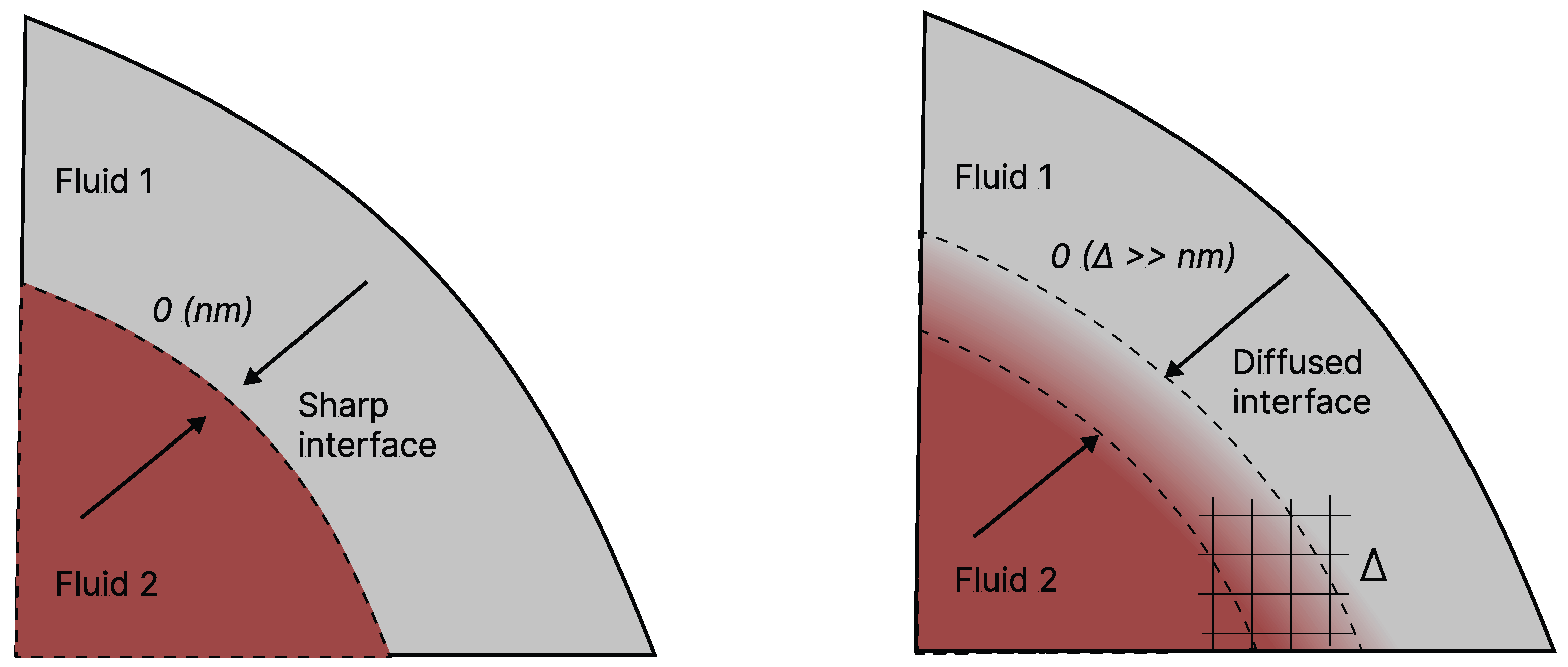
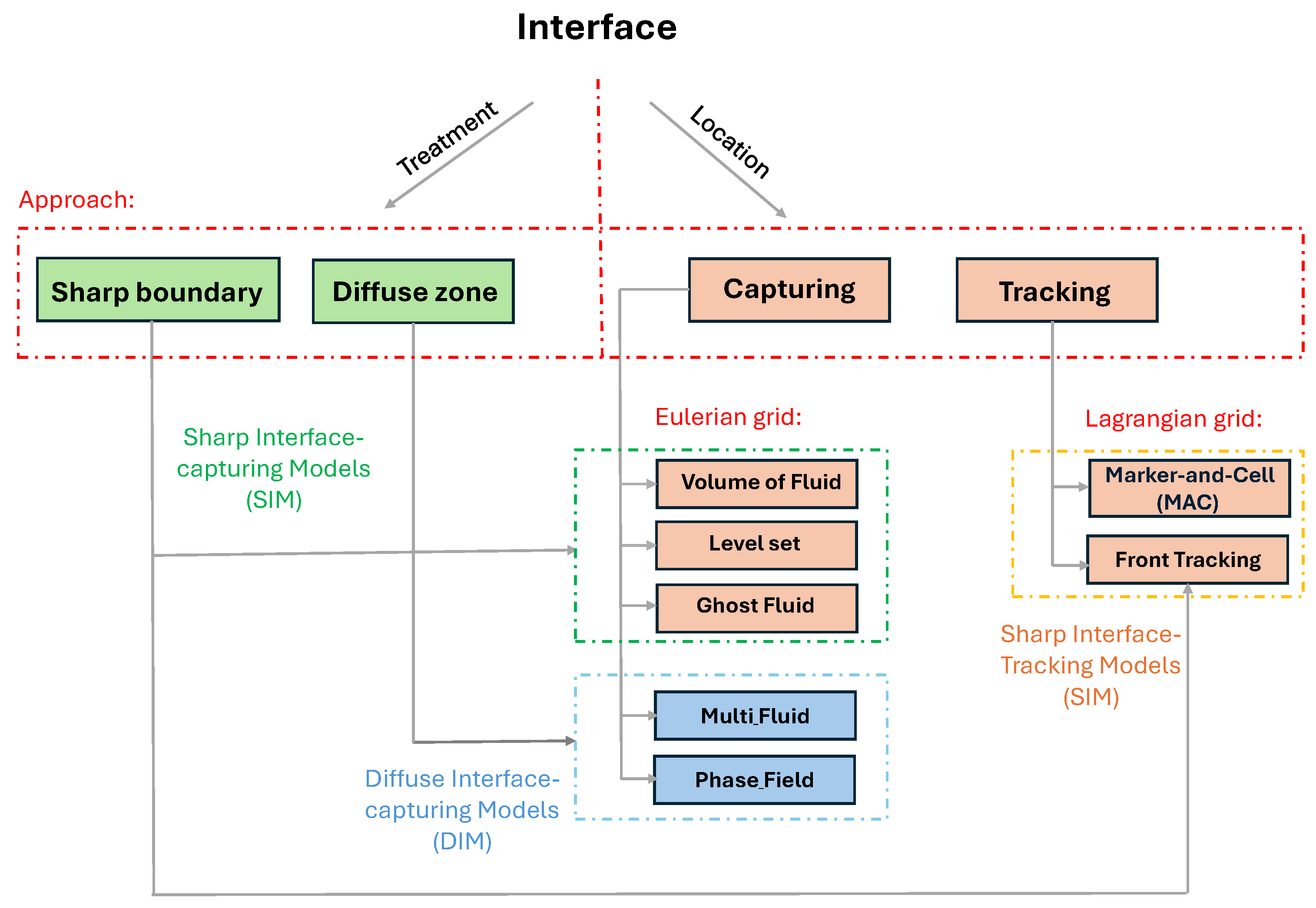


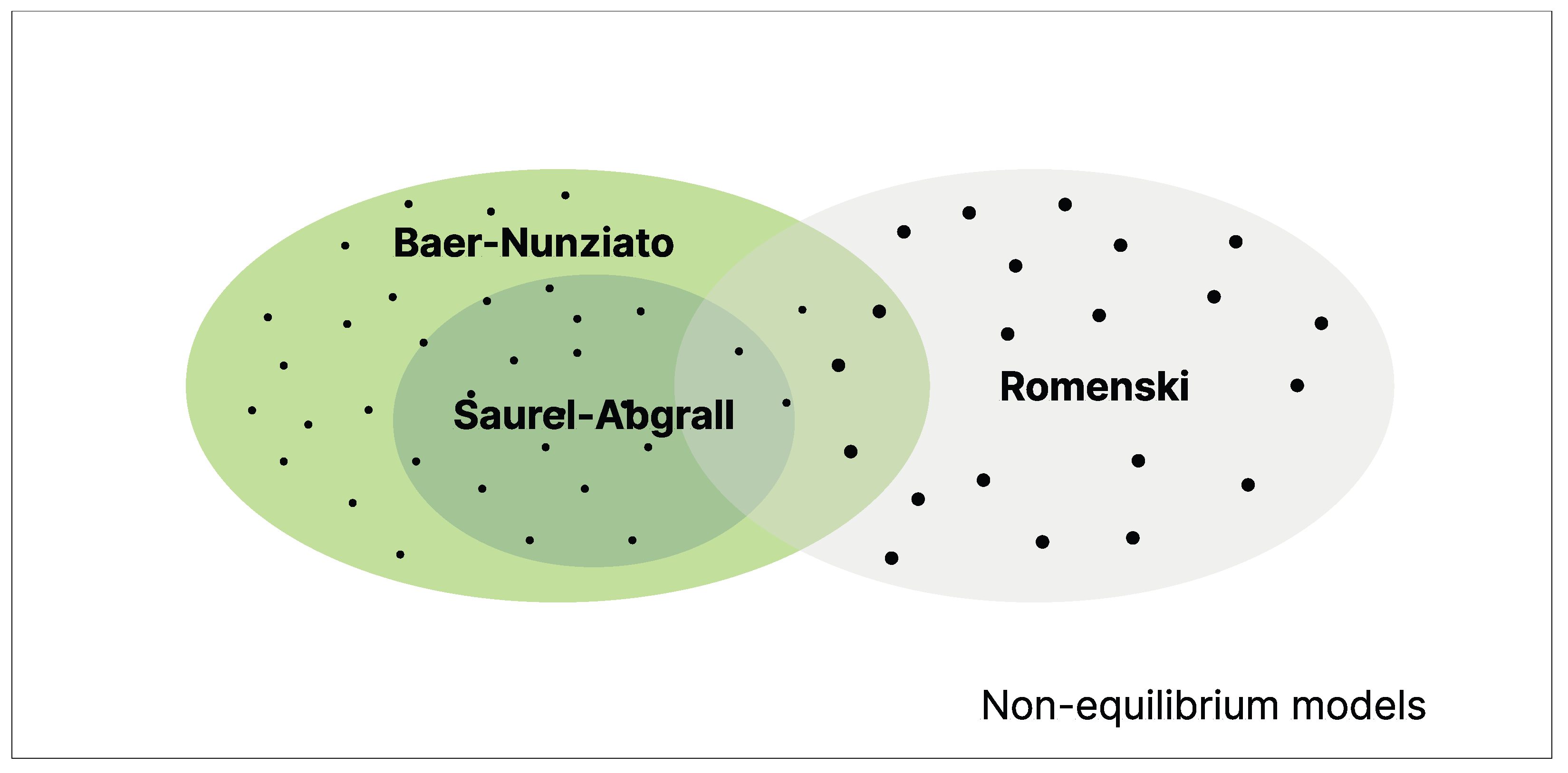
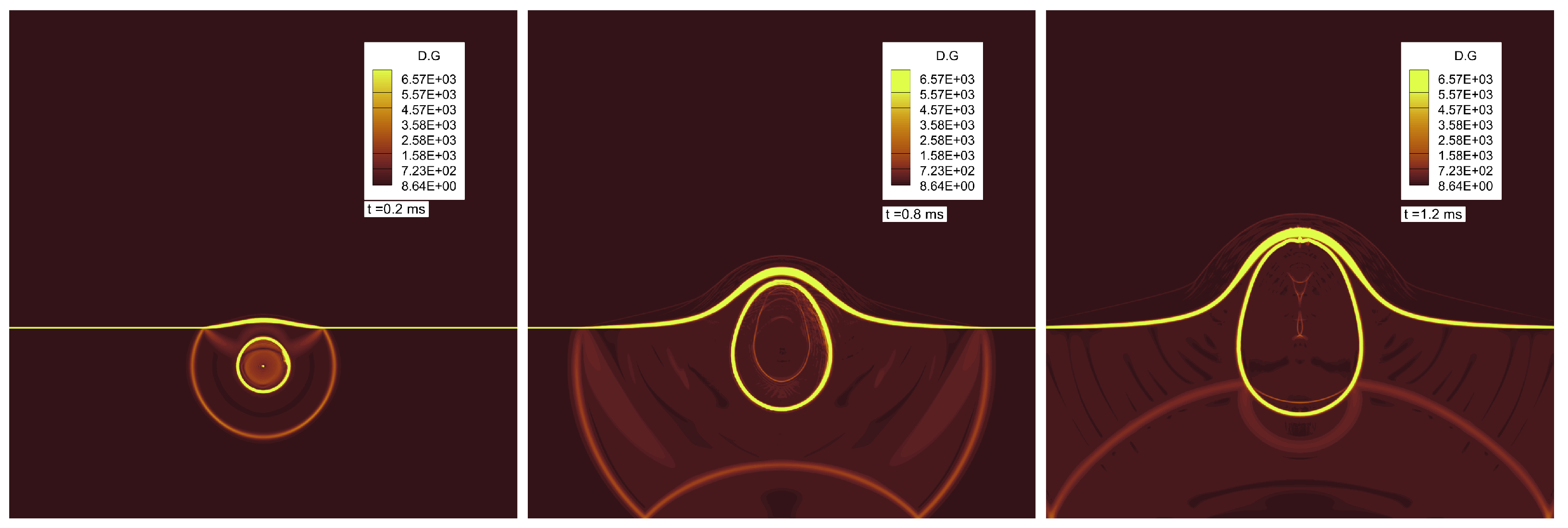
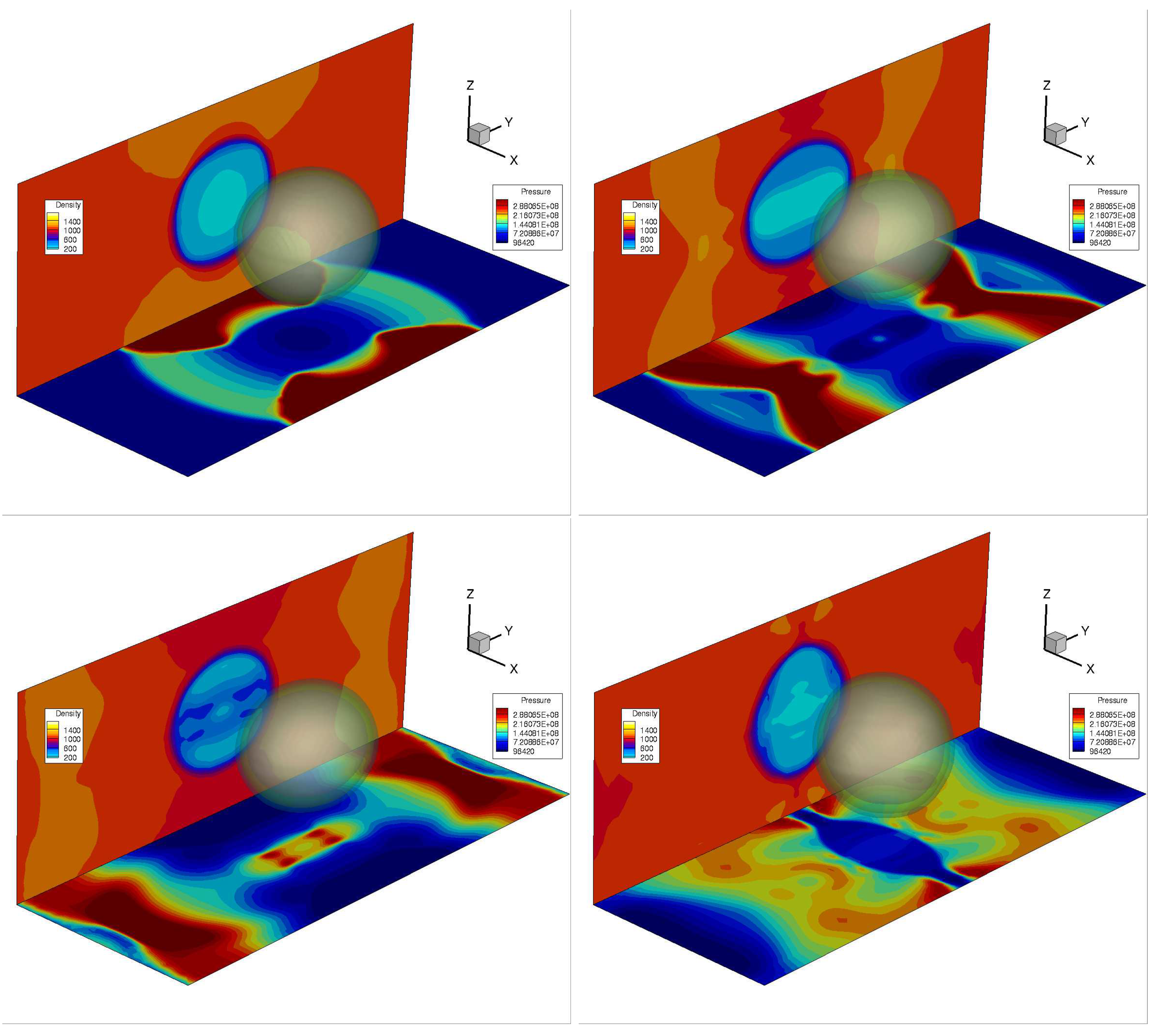
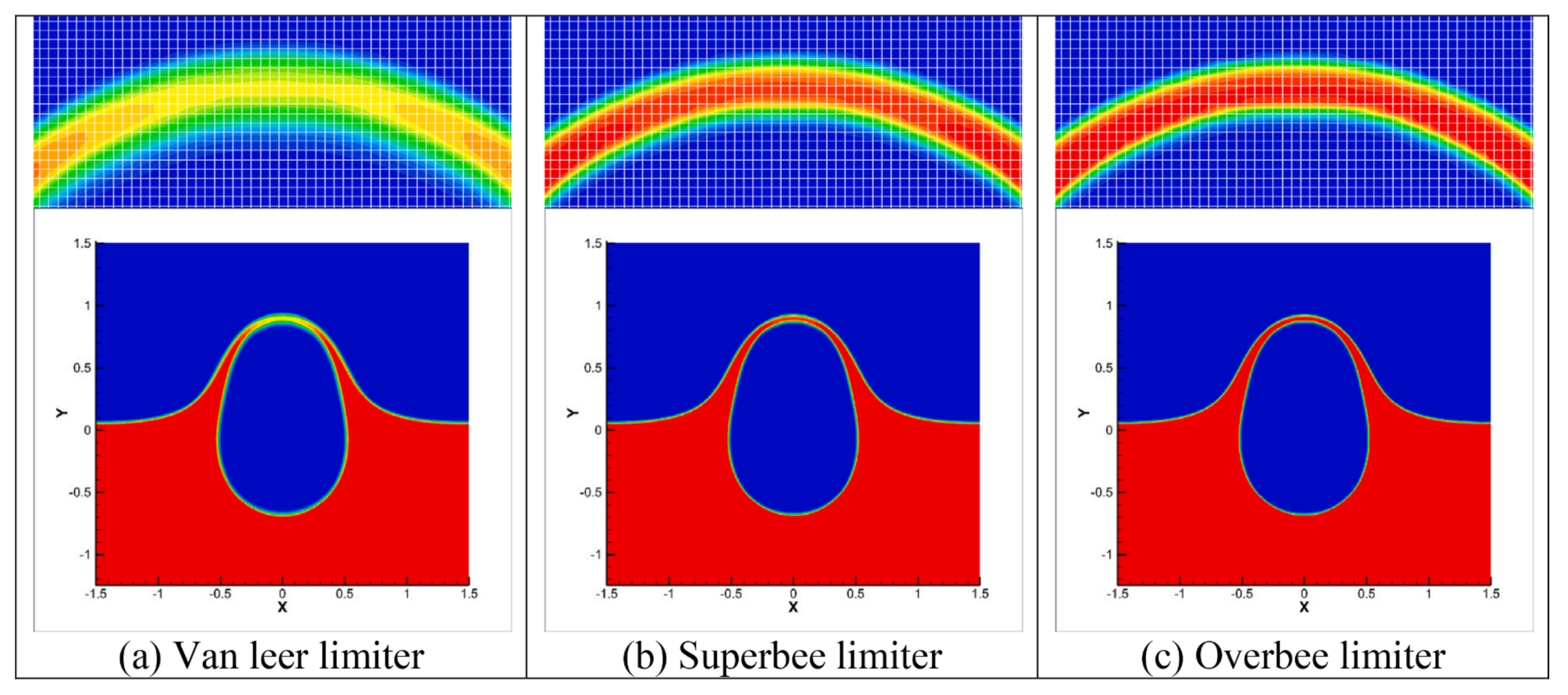
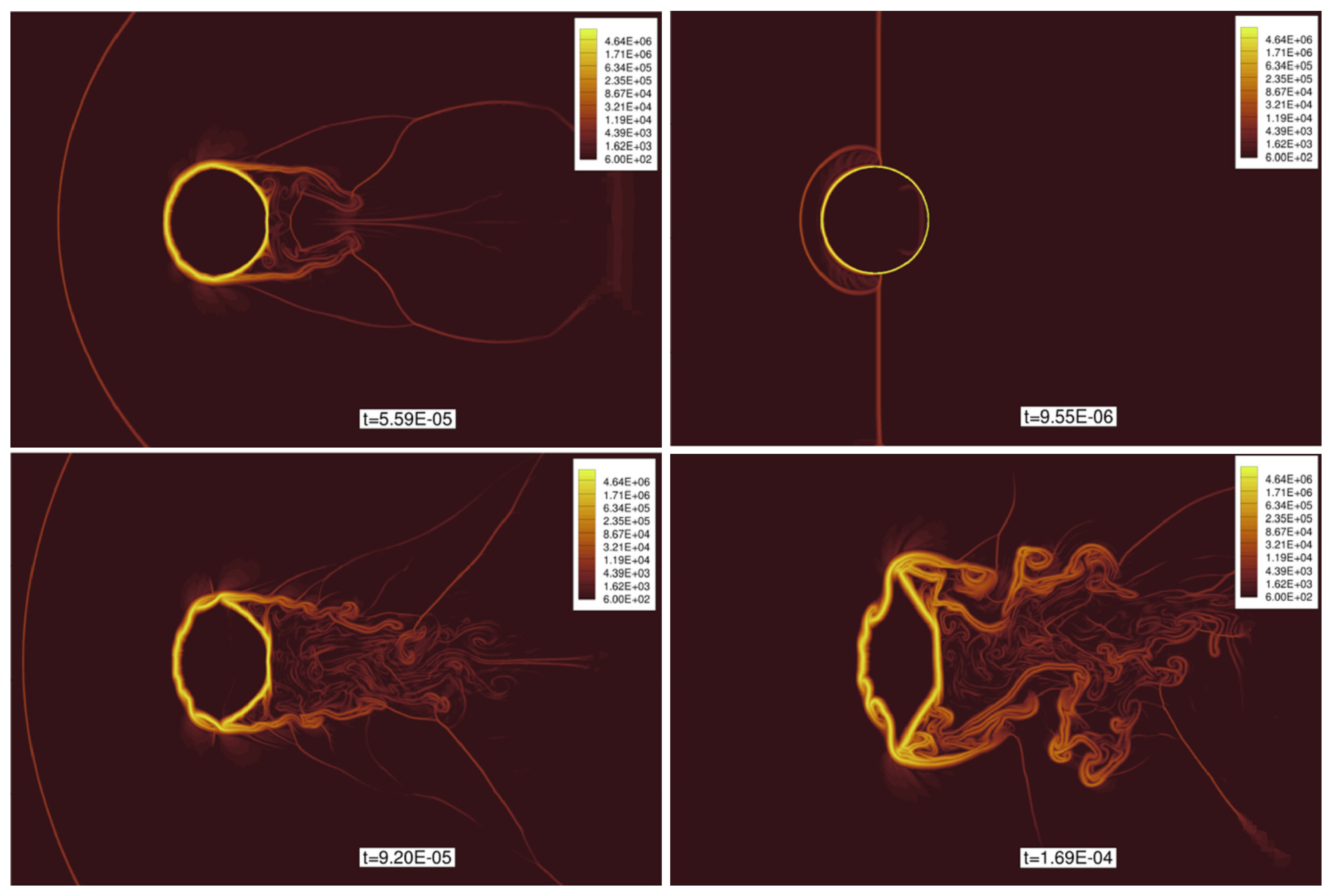
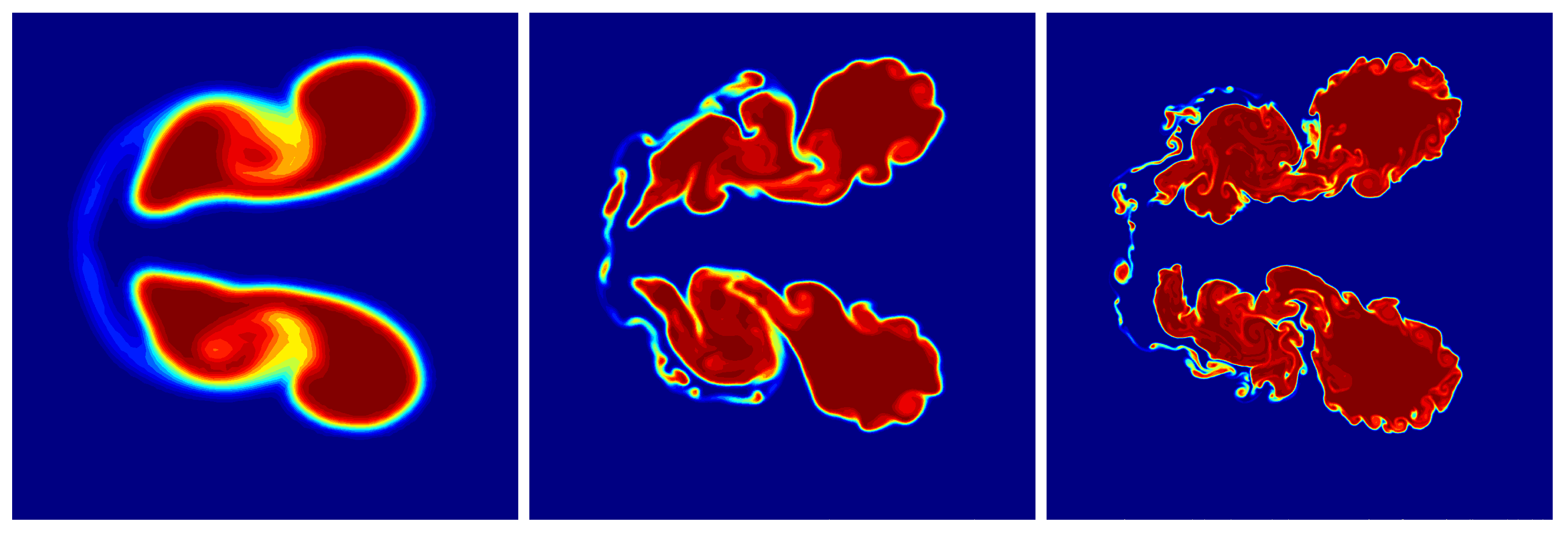

| High-Order Method | Framework | Literature |
|---|---|---|
| DG | Finite Element | [67,73,104] |
| ADER-DG | Finite Element | [75] |
| WENO | Finite Volume/Finite Difference | [53,54,91,105,106,107] |
| WENO-Z, WENO-JS | Finite Volume/Finite Difference | [52,76,77] |
| CWENO | Finite Volume/Finite Difference | [65,66] |
| TENO | Finite Volume/Finite Difference | [78] |
| MOOD | Finite Volume/Finite Difference | [79] |
| MUSCL | Finite Volume/Finite Difference | [52,56,80,81,83,84,85,108] |
| WENO-DG, MUSCL-DG | Hybrid DG-FV | [86,87,109] |
| LBM | Lattice Boltzmann | [110] |
| Methods | 5-eqn. DIM | 6-eqn. DIM | 7-eqn. DIM |
|---|---|---|---|
| Anti-diffusion | U [51,111] | U [111,113] | NYU |
| THINC | U [58,64,114,117,118] | U [115] | NYU |
| Limiter Techniques (e.g., TVD, BVD) | U [56,88,119,120] | NYU | NYU |
| Interface Compression | U [81,82,121,122] | NYU | NYU |
Disclaimer/Publisher’s Note: The statements, opinions and data contained in all publications are solely those of the individual author(s) and contributor(s) and not of MDPI and/or the editor(s). MDPI and/or the editor(s) disclaim responsibility for any injury to people or property resulting from any ideas, methods, instructions or products referred to in the content. |
© 2025 by the authors. Licensee MDPI, Basel, Switzerland. This article is an open access article distributed under the terms and conditions of the Creative Commons Attribution (CC BY) license (https://creativecommons.org/licenses/by/4.0/).
Share and Cite
Adebayo, E.M.; Tsoutsanis, P.; Jenkins, K.W. A Review of Diffuse Interface-Capturing Methods for Compressible Multiphase Flows. Fluids 2025, 10, 93. https://doi.org/10.3390/fluids10040093
Adebayo EM, Tsoutsanis P, Jenkins KW. A Review of Diffuse Interface-Capturing Methods for Compressible Multiphase Flows. Fluids. 2025; 10(4):93. https://doi.org/10.3390/fluids10040093
Chicago/Turabian StyleAdebayo, Ebenezer Mayowa, Panagiotis Tsoutsanis, and Karl W. Jenkins. 2025. "A Review of Diffuse Interface-Capturing Methods for Compressible Multiphase Flows" Fluids 10, no. 4: 93. https://doi.org/10.3390/fluids10040093
APA StyleAdebayo, E. M., Tsoutsanis, P., & Jenkins, K. W. (2025). A Review of Diffuse Interface-Capturing Methods for Compressible Multiphase Flows. Fluids, 10(4), 93. https://doi.org/10.3390/fluids10040093









